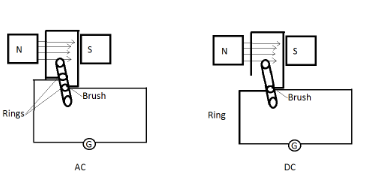
The essential difference between AC and DC generator is:
a) AC generators have an electromagnet while a DC generator has a permanent magnet.
b) DC generators will generate a higher voltage.
c) AC generators will generate a higher voltage.
d) AC generator has slip rings while the DC generator has a commutator.
Answer
588.3k+ views
Hint - In a generator the commutator picks off the current generated in the windings, reversing the direction of the current with each half turn, serving as a mechanical rectifier to convert the alternating current from the windings to unidirectional direct current in the external load circuit.
Complete step-by-step answer:
In AC generators we have slip rings whereas in DC generators we have commutators, whereas both can produce any given amount of voltage and an AC generator has an electromagnet while a DC generator has a permanent magnet.

Thus, option D is correct.
Note: In these types of questions, we should be aware of the components of AC and DC generators and their functions. Slip rings are two hollow rings to which two ends of the armature coil are connected. These rings rotate with the rotation of the coil. Its purpose is to allow for electrical contact with the brushes.
Complete step-by-step answer:
In AC generators we have slip rings whereas in DC generators we have commutators, whereas both can produce any given amount of voltage and an AC generator has an electromagnet while a DC generator has a permanent magnet.

Thus, option D is correct.
Note: In these types of questions, we should be aware of the components of AC and DC generators and their functions. Slip rings are two hollow rings to which two ends of the armature coil are connected. These rings rotate with the rotation of the coil. Its purpose is to allow for electrical contact with the brushes.
Recently Updated Pages
Master Class 12 English: Engaging Questions & Answers for Success

Master Class 12 Economics: Engaging Questions & Answers for Success

Master Class 12 Social Science: Engaging Questions & Answers for Success

Master Class 12 Maths: Engaging Questions & Answers for Success

Master Class 12 Chemistry: Engaging Questions & Answers for Success

Master Class 12 Business Studies: Engaging Questions & Answers for Success

Trending doubts
What are the major means of transport Explain each class 12 social science CBSE

Which are the Top 10 Largest Countries of the World?

Draw a labelled sketch of the human eye class 12 physics CBSE

Explain sex determination in humans with line diag class 12 biology CBSE

The pH of the pancreatic juice is A 64 B 86 C 120 D class 12 biology CBSE

Explain sex determination in humans with the help of class 12 biology CBSE




